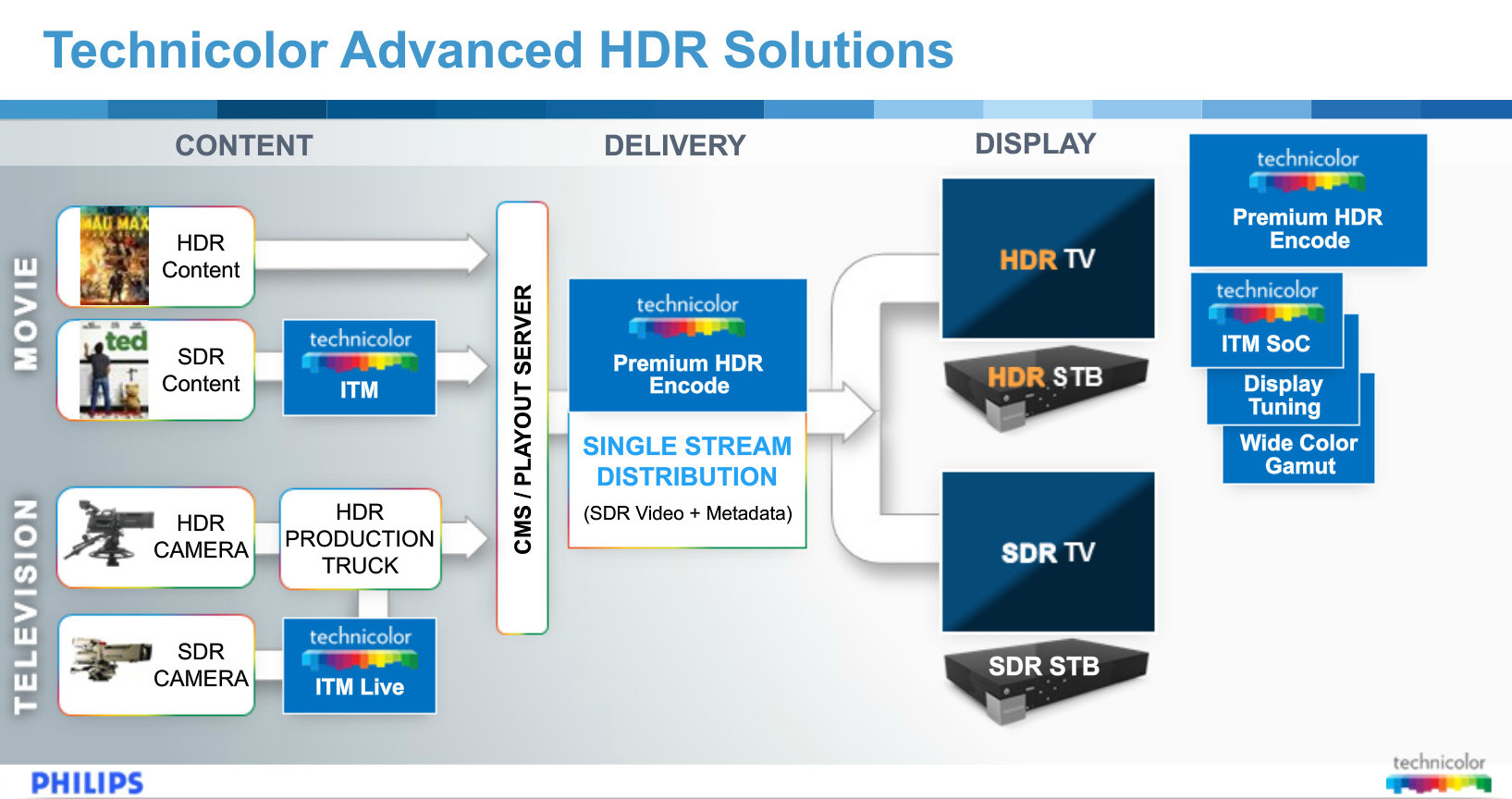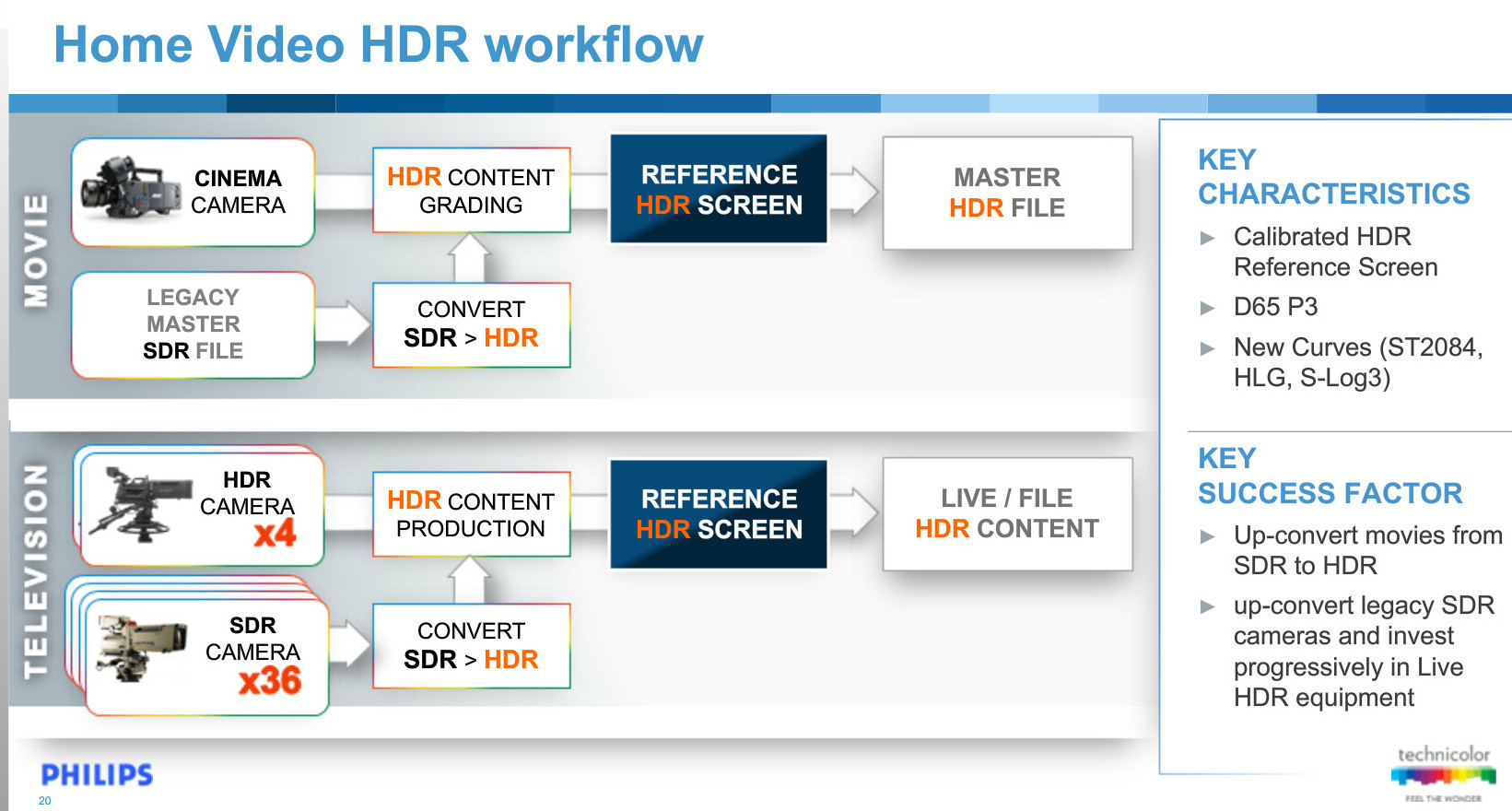TECHNICOLOR AND VUBIQUITY OFFER INDUSTRY FIRST “IN-NETWORK” HIGH DYNAMIC RANGE UP-CONVERSION AND DISTRIBUTION SERVICES FOR GLOBAL TV AND OTT PROVIDERS
April 11, 2016
Technicolor and VUBIQUITY are working together to accelerate the availability of High Dynamic Range (HDR) content to consumers around the world.
Los Angeles, CA – April 11, 2016 – Technicolor (Euronext Paris: TCH; OTCQX: TCLRY), a worldwide technology leader in the media and entertainment sector, and VUBIQUITY, the global premium content service provider connecting content owners and video providers to deliver entertainment to viewers on any screen, are working together to accelerate the availability of High Dynamic Range (HDR) content to consumers around the world. VUBIQUITY will incorporate Technicolor technologies to offer the industry’s first “in-network” HDR up-conversion and delivery service to network service providers and content owners.
Until now, access to HDR content has been limited to a small number of theatrical titles and OTT episodic programs delivered to HDR Smart TVs. The service will enable any network to offer consumers both live linear programming and video-on-demand (VOD) in HDR. It will dramatically increase the amount of enhanced content available to consumers over a growing variety of TVs and devices, including set-top boxes. It also introduces business opportunities for TV networks, broadcasters and Pay-TV providers interested in offering new premium services.
“This announcement contributes to Technicolor’s ongoing mission to bring the best and most immersive cinematic-quality experience to as many people as possible around the world,” said Mark Turner, VP Corporate Partnerships & Alliances at Technicolor. “VUBIQUITY has a global network with hundreds of content partners and distributors. By embedding Technicolor technology into VUBIQUITY’s services, visually richer HDR experiences can reach more consumers at a faster pace.”
VUBIQUITY customers will not only be able to offer native HDR content to consumers, but also deliver SDR content that is automatically up-converted to HDR. This will make it possible for service providers to offer consumers with the latest TV technologies to enjoy “all HDR, all the time” programming.
“At VUBIQUITY we’re always looking for new technologies to enhance our suite of content services. Technicolor’s award-winning HDR technologies are a great addition to make available to our clients,” said Gabriel Berger, EVP Sales for VUBIQUITY. “Technicolor’s single stream and HDR up-conversion technologies are tools our clients will be able to access this year to dramatically expand their HDR capabilities.”
The initiative will embed two of Technicolor’s advanced HDR technologies within the VUBIQUITY suite of content services:
Technicolor’s HDR Intelligent Tone Management solution allows programmers to “up-convert” existing Standard Dynamic Range (SDR) content to HDR. This award-winning up-conversion technology transforms existing SDR libraries into stunning HDR content that service providers can offer at premium rates.
Technicolor’s HDR distribution technology is “backwards compatible,” meaning encoded video can be delivered through a single stream to both HDR-enabled devices as well as older TV sets with legacy SDR displays. This cross-functionality means VUBIQUITY can offer service providers a cost-efficient way to migrate to HDR while “future-proofing” their networks to support emerging content formats.
A commercial launch of this new HDR service is expected later in 2016. Technicolor and VUBIQUITY will be demonstrating the new capabilities in a live broadcast that simulates a channel primetime broadcast at NAB 2016. It will be on display at Technicolor’s venue located in the Paramount Room at the Renaissance Hotel. Reservations are required to access this private area. To schedule an appointment please contact: HDRinfo@technicolor.com.
###
About VUBIQUITY
VUBIQUITY connects content owners and video providers to deliver entertainment to viewers on any screen. Working with over 600 leading film studios, television networks, independent producers and MCNs, VUBIQUITY brings premium content to over 750 global video distributors. Privately held, VUBIQUITY has offices in Los Angeles and London. For the latest company news, follow us on Twitter @Vubiquity. For more information visit: www.vubiquity.com
About Technicolor
Technicolor, a worldwide technology leader in the media and entertainment sector, is at the forefront of digital innovation. Our world-class research and innovation laboratories enable us to lead the market in delivering advanced video services to content creators and distributors. We also benefit from an extensive intellectual property portfolio focused on imaging technologies. Our commitment: supporting the delivery of exciting new experiences for consumers in theaters, homes and on-the-go. For more information visit: www.technicolor.com
Technicolor shares are on the NYSE Euronext Paris exchange (TCH) and traded in the USA on the OTCQX marketplace (TCLRY).
Technicolor Press Contact:
Lane Cooper
Lcooper@technicolorpr.com
415 646 6592
VUBIQUITY Press Contact:
Mallory Weinberg
Mallory.Weinberg@finsbury.com
516 567 0460
April 11, 2016
Technicolor and VUBIQUITY are working together to accelerate the availability of High Dynamic Range (HDR) content to consumers around the world.
Los Angeles, CA – April 11, 2016 – Technicolor (Euronext Paris: TCH; OTCQX: TCLRY), a worldwide technology leader in the media and entertainment sector, and VUBIQUITY, the global premium content service provider connecting content owners and video providers to deliver entertainment to viewers on any screen, are working together to accelerate the availability of High Dynamic Range (HDR) content to consumers around the world. VUBIQUITY will incorporate Technicolor technologies to offer the industry’s first “in-network” HDR up-conversion and delivery service to network service providers and content owners.
Until now, access to HDR content has been limited to a small number of theatrical titles and OTT episodic programs delivered to HDR Smart TVs. The service will enable any network to offer consumers both live linear programming and video-on-demand (VOD) in HDR. It will dramatically increase the amount of enhanced content available to consumers over a growing variety of TVs and devices, including set-top boxes. It also introduces business opportunities for TV networks, broadcasters and Pay-TV providers interested in offering new premium services.
“This announcement contributes to Technicolor’s ongoing mission to bring the best and most immersive cinematic-quality experience to as many people as possible around the world,” said Mark Turner, VP Corporate Partnerships & Alliances at Technicolor. “VUBIQUITY has a global network with hundreds of content partners and distributors. By embedding Technicolor technology into VUBIQUITY’s services, visually richer HDR experiences can reach more consumers at a faster pace.”
VUBIQUITY customers will not only be able to offer native HDR content to consumers, but also deliver SDR content that is automatically up-converted to HDR. This will make it possible for service providers to offer consumers with the latest TV technologies to enjoy “all HDR, all the time” programming.
“At VUBIQUITY we’re always looking for new technologies to enhance our suite of content services. Technicolor’s award-winning HDR technologies are a great addition to make available to our clients,” said Gabriel Berger, EVP Sales for VUBIQUITY. “Technicolor’s single stream and HDR up-conversion technologies are tools our clients will be able to access this year to dramatically expand their HDR capabilities.”
The initiative will embed two of Technicolor’s advanced HDR technologies within the VUBIQUITY suite of content services:
Technicolor’s HDR Intelligent Tone Management solution allows programmers to “up-convert” existing Standard Dynamic Range (SDR) content to HDR. This award-winning up-conversion technology transforms existing SDR libraries into stunning HDR content that service providers can offer at premium rates.
Technicolor’s HDR distribution technology is “backwards compatible,” meaning encoded video can be delivered through a single stream to both HDR-enabled devices as well as older TV sets with legacy SDR displays. This cross-functionality means VUBIQUITY can offer service providers a cost-efficient way to migrate to HDR while “future-proofing” their networks to support emerging content formats.
A commercial launch of this new HDR service is expected later in 2016. Technicolor and VUBIQUITY will be demonstrating the new capabilities in a live broadcast that simulates a channel primetime broadcast at NAB 2016. It will be on display at Technicolor’s venue located in the Paramount Room at the Renaissance Hotel. Reservations are required to access this private area. To schedule an appointment please contact: HDRinfo@technicolor.com.
###
About VUBIQUITY
VUBIQUITY connects content owners and video providers to deliver entertainment to viewers on any screen. Working with over 600 leading film studios, television networks, independent producers and MCNs, VUBIQUITY brings premium content to over 750 global video distributors. Privately held, VUBIQUITY has offices in Los Angeles and London. For the latest company news, follow us on Twitter @Vubiquity. For more information visit: www.vubiquity.com
About Technicolor
Technicolor, a worldwide technology leader in the media and entertainment sector, is at the forefront of digital innovation. Our world-class research and innovation laboratories enable us to lead the market in delivering advanced video services to content creators and distributors. We also benefit from an extensive intellectual property portfolio focused on imaging technologies. Our commitment: supporting the delivery of exciting new experiences for consumers in theaters, homes and on-the-go. For more information visit: www.technicolor.com
Technicolor shares are on the NYSE Euronext Paris exchange (TCH) and traded in the USA on the OTCQX marketplace (TCLRY).
Technicolor Press Contact:
Lane Cooper
Lcooper@technicolorpr.com
415 646 6592
VUBIQUITY Press Contact:
Mallory Weinberg
Mallory.Weinberg@finsbury.com
516 567 0460


Comment